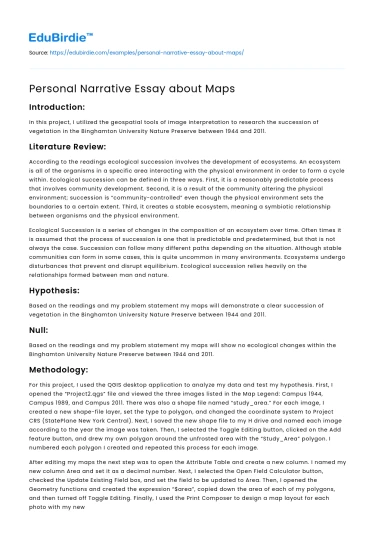Introduction:
In this project, I utilized the geospatial tools of image interpretation to research the succession of vegetation in the Binghamton University Nature Preserve between 1944 and 2011.
Literature Review:
According to the readings ecological succession involves the development of ecosystems. An ecosystem is all of the organisms in a specific area interacting with the physical environment in order to form a cycle within. Ecological succession can be defined in three ways. First, it is a reasonably predictable process that involves community development. Second, it is a result of the community altering the physical environment; succession is “community-controlled” even though the physical environment sets the boundaries to a certain extent. Third, it creates a stable ecosystem, meaning a symbiotic relationship between organisms and the physical environment.
Save your time!
We can take care of your essay
- Proper editing and formatting
- Free revision, title page, and bibliography
- Flexible prices and money-back guarantee
Ecological Succession is a series of changes in the composition of an ecosystem over time. Often times it is assumed that the process of succession is one that is predictable and predetermined, but that is not always the case. Succession can follow many different paths depending on the situation. Although stable communities can form in some cases, this is quite uncommon in many environments. Ecosystems undergo disturbances that prevent and disrupt equilibrium. Ecological succession relies heavily on the relationships formed between man and nature.
Hypothesis:
Based on the readings and my problem statement my maps will demonstrate a clear succession of vegetation in the Binghamton University Nature Preserve between 1944 and 2011.
Null:
Based on the readings and my problem statement my maps will show no ecological changes within the Binghamton University Nature Preserve between 1944 and 2011.
Methodology:
For this project, I used the QGIS desktop application to analyze my data and test my hypothesis. First, I opened the “Project2.qgs” file and viewed the three images listed in the Map Legend: Campus 1944, Campus 1989, and Campus 2011. There was also a shape file named “study_area.” For each image, I created a new shape-file layer, set the type to polygon, and changed the coordinate system to Project CRS (StatePlane New York Central). Next, I saved the new shape file to my H drive and named each image according to the year the image was taken. Then, I selected the Toggle Editing button, clicked on the Add feature button, and drew my own polygon around the unfrosted area with the “Study_Area” polygon. I numbered each polygon I created and repeated this process for each image.
After editing my maps the next step was to open the Attribute Table and create a new column. I named my new column Area and set it as a decimal number. Next, I selected the Open Field Calculator button, checked the Update Existing Field box, and set the field to be updated to Area. Then, I opened the Geometry functions and created the expression “$area”, copied down the area of each of my polygons, and then turned off Toggle Editing. Finally, I used the Print Composer to design a map layout for each photo with my new polygons. I exported my maps as JPG files.
Results:
Based on the maps I have created using the QGIS desktop application I can confidently disprove my null. There is clear and steady evidence that supports an ecological succession between 1944 and 2011 in the Binghamton University Nature Preserve. I created maps for the years presented and I was able to draw polygons around the unforested areas that were found in the Preserve. The area that was unforested in 1944 was 240120.410827396, in 1989 it was 588747.848754883, and in 2011 it was 700966.40625. Over the years the amount of unforested area has steadily increased.
Summary and Conclusion:
During this project, I observed and examined the ecological succession that took place within Binghamton University’s Nature Preserve between 1944 and 2011. I created 3 maps for 1944, 1989, and 2011. I drew polygons around the unforested areas within the study area and compared the area values. I can conclude that there was a steady increase in unforested areas between 1944 and 2011. For future research, I would try and understand the cause of this increase and how we can prevent it. I think it would be interesting to study the different species that grow within the Preserve, which species tend to thrive through the succession, and which species’ are filtered out.






 Stuck on your essay?
Stuck on your essay?

